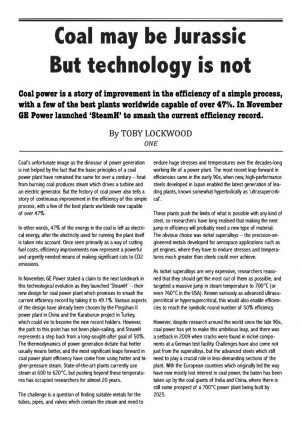 Coal’s unfortunate image as the dinosaur of power generation is not helped by the fact that the basic principles of a coal power plant have remained the same for over a century – heat from burning coal produces steam which drives a turbine and an electric generator. But the history of coal power also tells a story of continuous improvement in the efficiency of this simple process, with a few of the best plants worldwide now capable of over 47%.
Coal’s unfortunate image as the dinosaur of power generation is not helped by the fact that the basic principles of a coal power plant have remained the same for over a century – heat from burning coal produces steam which drives a turbine and an electric generator. But the history of coal power also tells a story of continuous improvement in the efficiency of this simple process, with a few of the best plants worldwide now capable of over 47%.
In other words, 47% of the energy in the coal is left as electrical energy, after the electricity used for running the plant itself is taken into account. Once seen primarily as a way of cutting fuel costs, efficiency improvements now represent a powerful and urgently needed means of making significant cuts to CO2 emissions.
In November, GE Power staked a claim to the next landmark in this technological evolution as they launched ‘SteamH’ – their new design for coal power plant which promises to smash the current efficiency record by taking it to 49.1%. Various aspects of the design have already been chosen by the Pingshan II power plant in China and the Karaburun project in Turkey, which could vie to become the new record holders. However, the path to this point has not been plain-sailing, and SteamH represents a step back from a long-sought-after goal of 50%. The thermodynamics of power generation dictate that hotter usually means better, and the most significant leaps forward in coal power plant efficiency have come from using hotter and higher-pressure steam. State-of-the-art plants currently use steam at 600 to 620°C, but pushing beyond these temperatures has occupied researchers for almost 20 years.
The challenge is a question of finding suitable metals for the tubes, pipes, and valves which contain the steam and need to endure huge stresses and temperatures over the decades-long working life of a power plant. The most recent leap forward in efficiencies came in the early 90s, when new, high-performance steels developed in Japan enabled the latest generation of leading plants, known somewhat hyperbolically as ‘ultrasupercritical’.
These plants push the limits of what is possible with any kind of steel, so researchers have long realised that making the next jump in efficiency will probably need a new type of material. The obvious choice was nickel superalloys – the precision-engineered metals developed for aerospace applications such as jet engines, where they have to endure stresses and temperatures much greater than steels could ever achieve.
As nickel superalloys are very expensive, researchers reasoned that they should get the most out of them as possible, and targeted a massive jump in steam temperature to 700°C (or even 760°C in the USA). Known variously as advanced ultrasupercritical or hypersupercritical, this would also enable efficiencies to reach the symbolic round number of 50% efficiency.
However, despite research around the world since the late 90s, coal power has yet to make this ambitious leap, and there was a setback in 2009 when cracks were found in nickel components at a German test facility. Challenges have also come not just from the superalloys, but the advanced steels which still need to play a crucial role in less-demanding sections of the plant. With the European countries which originally led the way have now mostly lost interest in coal power, the baton has been taken up by the coal giants of India and China, where there is still some prospect of a 700°C power plant being built by 2025.
Since acquiring rivals Alstom in 2015, GE holds a huge share of the market for coal power plant, and has sought to emphasise its status as a technology leader and champion of cleaner coal, with many of the most efficient plants already to its name. SteamH is essentially born of a pragmatic look at the wealth of knowledge acquired, both from operating these state-of-the-art plants and the twenty years spent striving towards 700°C steam. If 700°C is (for now) not commercially viable, what about aiming a little lower?
The new design obtains its 49.1% efficiency with steam temperatures of 650 to 670°C, using some of the nickel alloys developed while aiming for 700°C in high-stress areas of the plant, and some of the best currently used steels in less-demanding areas. GE’s experience with plants and materials at the cutting edge has given them confidence in operating some of these metals at their limits, but all will be used within their established safety standards. This is an important point, as the long process of obtaining formal certificates to operate metals under new conditions has been a major hold-up in reaching 700°C.
Aside from hotter steam, GE have also turned to a trendier technology to make efficiency gains – data analysis. Coal power stations can have over 10000 sensors monitoring things ranging from temperature to chemical composition all over the plant, but this flood of data is rarely used effectively.
GE developed a cloud-based ‘digital power plant’ tool which uses artificial intelligence to analyse data and work out the optimum settings for getting the most out of the plant at any given moment. This ability to rapidly respond to changes has become even more important as coal plants are expected to turn up and down as backup to wind and solar power.
So, what about the ever-elusive 50% target? The use of SteamH in China’s Pingshan II project represents an interesting coming together of coal technologies that could yet see this milestone reached. Pingshan II is itself an evolution of Shanghai Shenergy’s Waigaoqiao plant, which currently disputes the coal efficiency record with GE’s own RDK8 plant in Karlsruhe, Germany.
Based on a holistic approach which has been likened to Chinese medicine, the operators of Waigaoqiao have managed to eke out every bit of power from the plant through a series of small optimisations such as keeping the steam thoroughly clean of solid particles. Pingshan II aims to take these principles and new ideas from Shanghai Shenergy to reach up to 49.8%. The inclusion of SteamH in the project represents a kind of supergroup of coal power design. Edging up coal plant efficiency by a few percent may not seem all that impressive in the context of the 10 billion tons of CO2 a year currently associated with coal power, and the huge carbon cuts necessary to mitigate further climate change.
However, it is precisely the enormous scale of coal exploitation which gives these advances such power. Most of the world’s current coal plants perform well below these efficiency chart-toppers (at an average of around 35%), and many more poorly performing plants are being built every year. If all these plants could be converted to the current state-of-the-art, savings of over 2 billion tons of CO2 could be made annually. Not bad for a dinosaur.
Toby Lockwood





